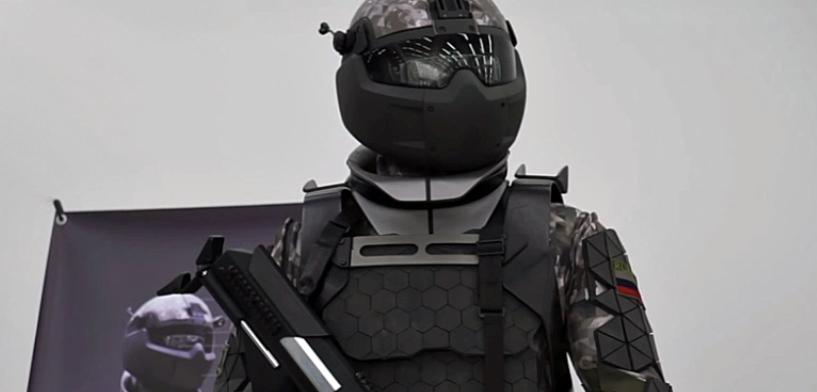US Army’s Future “Supersoldiers”
December 4, 2018 | Expert Insights

B-TEMIA and Lockheed’s proprietary wearable technology provides users with robotised mechanical support to restore, maintain or enhance the mobility of users, with applications in the medical, industrial and military fields.
Background
B-TEMIA is a bio-robotics technology company founded in 2010. The proprietary technology behind B-TEMIA’s product portfolio is the result of an emerging science called “Dermoskeletics”. Dermoskeletics studies the interaction between the human body and its environment while assisting with a skin-type motorised mechanism. B-TEMIA develops, manufactures and commercialises cutting-edge products in the growing market of human augmentation systems. Previously, the United States’ Special Operations Command (SOCOM) has supported research into combat exoskeleton prototypes. B-TEMIA’s medically focused system, called Keeogo, is sold in Canada for about C$39,000. Lockheed Martin Corporation is an American global aerospace, defence, security and advanced technologies company with worldwide interests. It was formed by the merger of Lockheed Corporation with Martin Marietta in March 1995.
Modern ballistic body armour is a game-changing innovation that gives U.S. soldiers a significant battlefield advantage over adversaries. Militaries have long invested in protection, such as helmets and armour, but at present U.S. troops have greater protection than their historical predecessors or contemporaries around the globe. Nevertheless, this protection has limitations and dismounted troops remain vulnerable to a range of threats. Current body armour systems suffer from three major shortcomings: (i) current body armour does not adequately protect against blast-induced brain injury, a critical threat to soldiers, (ii) the weight of current armour negatively affects soldier performance, and (iii) despite their weight, current systems still leave vulnerable areas exposed.
Analysis
The U.S. Army is investing millions of dollars in experimental exoskeleton technology to make soldiers stronger and more resilient, in what experts say is part of a broader push into advanced gear to equip a new generation of “super-soldiers.” The technology is being developed by Lockheed Martin Corp (LMT.N) with a license from Canada-based B-TEMIA, which first developed the exoskeletons to help people with mobility difficulties stemming from medical ailments like multiple sclerosis and severe osteoarthritis. Worn over a pair of pants, the battery-operated exoskeleton uses a suite of sensors, artificial intelligence and other technology to aid natural movements.
For the U.S. military, the appeal of such technology is clear. Soldiers currently deploy into war zones bogged down by heavy but critical gear like body armour, night-vision goggles and advanced radios. Altogether, that can weigh anywhere from 90 to 140 pounds (40-64 kg), when the recommended limit is just 50 pounds.
“That means when people do show up to the fight, they’re fatigued,” said Paul Scharre at the Center for a New American Security (CNAS), who helped lead a series of studies on exoskeletons and other advanced gear. “The fundamental challenge we’re facing with infantry troops is they’re carrying too much weight.”
Lockheed Martin said on 29 November that it won a $6.9 million award from the U.S. Army Natick Soldier Research, Development and Engineering Center to research and develop the exoskeleton, called ONYX, under a two-year, sole-source agreement. Keith Maxwell, the exoskeleton technologies manager at Lockheed Martin Missiles and Fire Control, said people in his company’s trials who wore the exoskeletons showed far more endurance.
The United States is not the only country looking at exoskeleton technology. Samuel Bendett at the Center for Naval Analyses, a federally funded U.S. research and development centre, said Russia and China were also investing in exoskeleton technologies, “in parallel” to the US. Russia, in particular, was working on several versions of exoskeletons, including one that it tested recently in Syria, Bendett said. The CNAS analysis of the exoskeleton was part of a larger look by the Washington-based think tank at next-generation technologies that can aid soldiers, from better helmets to shield them from blast injuries to the introduction of robotic “teammates”.
Counterpoint
The history of the military and industries are littered with aspirational exoskeletons that never amounted to much. The technology is challenging because it needs to be responsive, reliable, and above all, safe.
Assessment
The protection from body armour has limitations and dismounted troops remain vulnerable to a range of threats. There is no magic solution for improving soldier survivability, but there are many opportunities that the U.S. military can seize upon that can yield significant improvements.
India Watch
Future Infantry Soldier as a System or F-INSAS is India's program to equip its infantry with state-of-the-art equipment. The program is modelled on the US military Future Warrior system.








Comments